Lugou Bridge Incident and Second Battle of Hebei
Contributor: C. Peter Chen
ww2dbaseThe Lugou Bridge Incident
7 Jul
ww2dbaseBeginning in late Jun 1937, the Japanese Kwangtung Army in the puppet state of Manchukuo located in northeastern China performed a large-scale military exercise near the Chinese border west of the Lugou Bridge (Marco Polo Bridge). While the military exercise in China was allowed per the 15 Jul 1902 supplemental agreement to the Boxer Protocol, the Japanese garrison size in the region was somewhere between 7,000 and 15,000, which was over the limit set by the protocol. In the night of 6 Jul 1937, unlike previous exercises, the Japanese Army failed to inform the local Chinese authorities that a night exercise was underway, leading to the Chinese forces mistakenly regarding the Japanese movement as a raid, and a few of the Chinese soldiers fired a number of ineffective rifle shots at the direction of the Japanese. At about 2300 hours, a small exchange of fire took place between the two sides. Very soon after, Japanese Kwangtung Army Major Kiyonao Ichiki reported that one of his soldiers failed to return. Suspecting that the soldier was captured by the Chinese, regimental commanding officer Colonel Renya Mutaguchi placed a telephone call to Colonel Ji Xingwen of the 219th Regiment, 37th Division, Chinese 29th Route Army, demanding that his troops be allowed to enter Chinese territory to search for the missing soldier; the request was rejected by the Chinese. At 2340, General Qin Dechun of the Chinese 29th Route Army was contacted by Japanese military intelligence with the same demand, and he also denied the request, but offered that he would dispatch his troops in the morning to search for the missing soldier; meanwhile, Qin ordered General Feng Zhian of the 37th Division to enter heightened alert. Before daybreak, the missing Japanese soldier turned up, though none of the senior officers at the regimental level were informed. At 0330 in the morning of 8 Jul 1937, four Japanese mountain guns and a machine gun company arrived in the area in preparation for hostilities. At about 0450, General Qin allowed two Japanese investigators to cross the border into the town of Wanping, where the missing soldier was suspected to be held. At 0500, Japanese machine guns opened fire at Chinese positions, while armored cars and infantrymen attacked the Lugou Bridge and a nearby railroad bridge. Colonel Ji and the 1,000 men under him defended Lugou Bridge, which was taken by the Japanese for a brief period on 8 Jul, but in the morning of 9 Jul, at about 0600, Chinese troops were able to retake it.
ww2dbaseIn Tokyo, Japan, Prime Minister Fumimaro Konoe held a cabinet meeting on 8 Jul in order to cool the tension and avert a full scale war. In China, Japanese military intelligence had also reached a verbal agreement for a ceasefire with General Qin, but Japanese China Garrison Infantry Brigade commander General Masakazu Kawabe refused to recognize the verbal agreement, and ordered his men to continue to shell the town of Wanping with artillery, which lasted for another three hours after the verbal agreement was reached. Kawabe's aggressive sentiment mirrored that of Japanese Army leadership in Tokyo, which wished to escalate the situation. The Japanese Army deployed an infantry division from the Japanese Chosen Army in Korea, two brigades from the Kwangtung Army, and an air regiment as reinforcement to the Lugou Bridge region. Political pressure caused the army leadership to rescind the reinforcements order on 11 Jul. On 12 Jul, Lieutenant General Kanichiro Tashiro of the Japanese China Garrison Army died from illness; General Kiyoshi Katsuki was named his successor. Katsuki ordered the shelling of Wanping to start again on 14 Jul.
ww2dbaseThe Lugou Bridge Incident is also referred to by a number of names, including Marco Polo Bridge Incident, and 7 Jul Incident (qi qi shibian). It is the official start of the Second Sino-Japanese War, and is wide recognized as the start of WW2 in China.
ww2dbaseThe Battle of Beiping-Tianjin
25 Jul-8 Aug
ww2dbaseOn 25 Jul, Japanese 20th Division arrived at the city of Langfang, which was on the railroad between Beiping and Tianjin, where the first major battle took place. On 26 Jul, a Japanese brigade attacked the Guanghua Gate of the Beiping city wall, supported by aircraft bombardment. On 27 Jul, as the Japanese laid siege to Chinese forces in Tungchow, one Chinese battalion broke out and fell back to Nanyuan.
ww2dbaseOn 28 Jul, the 20th Division and three independent combined brigades, with air support, launched an offensive against Beiping. The main objective was Nanyuan, and the secondary was Beiyuan. In this fighting, General Tong Linge (deputy commander of 29th Route Army) and General Zhao Dengyu (commander of 132nd Division) were both killed as Chinese forces generally suffered one defeat after another, though small tactical victories were achieved which slowed Japanese advances. During the night of 28 Jul, General Song Zheyuan, head of the Hebei-Chahar Political Council and commanding officer of the 29th Route Army, declared defeat and ordered his troops to withdraw southward. The civilian mayor of Tianjin was left in Beiping to take charge of political affairs in Hebei and Chahar Provinces with only General Liu Ruzhen's 29th Brigade in support to maintain public order. On 29 Jul, the city of Tianjin was attacked separately by the Japanese Army 5th Division and Japanese naval forces. Chinese troops in Tianjin held on to the city until 30 Jul before being ordered to retreat. On 4 Aug, General Liu Ruzhen's 29th Brigade withdrew from Beiping. Virtually undefended by this time, the Japanese entered Beiping on 8 Aug. General Masakazu Kawabe entered Beiping on 18 Aug and proclaimed himself the military governor of the city.
ww2dbaseThe Tongzhou Mutiny
29 Jul
ww2dbaseThe Japanese maintained the puppet East Hebei Government in eastern Hebei Province, China, with its capital in the city of Tongzhou. Tongzhou was also known by its official Chinese name of Tong Xian ("Tong County") as of 1914 when the Chinese government placed it under the jurisdiction of the city of Beiping as a subordinate county. Due to its status as the puppet government's capital city, the historical name of Tongzhou ("Tong City") was restored.
ww2dbaseOn 28 Jul, when the 800-strong Chinese detachment was nearly wiped out by the Japanese outside of Tongzhou, 5,000 Japanese-trained East Hebei Army troops mutinied against the Japanese. As they outnumbered Japanese personnel in the city, East Hebei troops soon took control and went into a killing frenzy and soon became out of control. Hundreds of Japanese military personnel, Japanese civilians, and Korean civilians working for the Japanese were massacred, and many Japanese women in the city were raped, and some were murdered. Much of the city was burned down. Only 60 Japanese civilians survived. The Japanese government used this massacre to justify the provocation of war with China.
ww2dbaseSource: Wikipedia
Last Major Update: May 2009
Lugou Bridge Incident and Second Battle of Hebei Interactive Map
Photographs
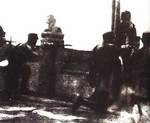 | 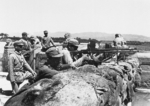 | 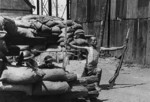 | 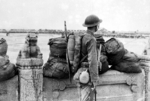 |
Maps
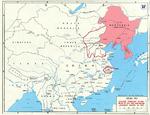 |
Lugou Bridge Incident and Second Battle of Hebei Timeline
| 6 Jul 1937 | Japanese troops conducted a night-time exercise near the border of China and the Japanese-sponsored puppet nation of Manchukuo in northeastern China. The Japanese authorities failed to give the Chinese notice, thus the Chinese guards regarded the Japanese troops as invaders and fired a number of rifle shots at them. At 2300 hours, the Japanese troops fired back, but would very soon pull back. Japanese Major Kiyonao Ichiki reported one of his men was missing after the brief fire fight, suspecting that he was captured by the Chinese. Before midnight, demands for the return of the missing soldiers were being sent to Chinese military headquarters. |
| 7 Jul 1937 | Even though the missing Japanese soldier suspected to have been captured by the Chinese near Beiping turned up, none of the Japanese officers at the regimental level were informed. |
| 8 Jul 1937 | At 0330 hours, four Japanese mountain gun crews and a machine gun company were ordered to prepare for an invasion of China. At 0500 hours (still 7 Jul 1937 for the western world on the other side of the International Date Line), the Japanese opened fire, starting the Second Sino-Japanese War. Japanese Prime Minister Fumimaro Konoe held a cabinet meeting in an attempt to find a solution to de-escalate the situation, but the Japanese Army was working in the opposite direction, planning to move the Japanese Chosen Army and Kwantung Army units to the contested region. |
| 9 Jul 1937 | Chen Jie met with Japanese diplomat Hidaka Shinkurou, demanding Japan to de-escalate the situation in northern China, to apologize, to punish the officers responsible, and to discuss reparations. |
| 11 Jul 1937 | Units of the Japanese Chosen Army and Kwantung Army, previously ordered to march into China on the first day of the Second Sino-Japanese War, was recalled due to political reasons. |
| 11 Jul 1937 | The Japanese Army and Japanese Navy agreed on a boundary in China. The Army was placed in charge of conducting the war in northern China, while the Navy would take on central and southern China. The Japanese Navy's air power in China at this time consisted of 80 aircraft aboard carriers Kaga, Ryujo, and Hosho. |
| 25 Jul 1937 | Japanese 20th Division clashed with Chinese troops at the city of Langfang, China, major rail junction between Beiping and Tianjin. This was the first major battle of the Second Sino-Japanese War. |
| 26 Jul 1937 | A Japanese brigade, supported by aircraft, attacked the Guanghua Gate of the Beiping, China city wall. |
| 27 Jul 1937 | Japanese troops besieged the city of Tongzhou (Tungchow), China. |
| 28 Jul 1937 | Troops of the Japanese 20th Division and three independent combined brigades, with air support, launched an offensive against Beiping, China. Discouraged, Chinese General Song Zheyuan, head of the Hebei-Chahar Political Council and the commanding officer of the 29th Route Army, announced defeat and withdrew from the city of Tianjin. |
| 29 Jul 1937 | Troops of the Japanese Army 5th Division and Japanese naval troops separately attacked the Chinese city of Tianjin. In Tongzhou near Beiping, 5,000 Japanese-trained East Hebei Army soldiers mutinied against the Japanese. The rebellion soon became out of control. Japanese civilians were rounded up and massacred, and there were many incidences of rape committed against Japanese women. Much of the city was burned down by the time East Hebei Army officers regained control of their men. The militant factions in the Japanese government would use this incident as one of the justifications for starting the Second Sino-Japanese War. |
| 30 Jul 1937 | Defending troops in Tianjin, China were ordered to withdraw from the city. |
| 4 Aug 1937 | The Chinese 29th Brigade under General Liu Ruzhen withdrew from Beiping, China. |
| 8 Aug 1937 | Japan declared Chinese cities of Beiping and Tianjin secure. |
| 18 Aug 1937 | Japanese Army General Masakazu Kawabe entered Beiping, China and proclaimed himself the military governor of the city. |
Please consider supporting us on Patreon. Even $1 per month will go a long way! Thank you. Please help us spread the word: Stay updated with WW2DB: |
Visitor Submitted Comments
12 Jun 2006 11:52:24 AM
After all these years why are the Americans are so kkowtow and protective of the nizieish Japanese? Why is the only negative documentry on Nizie Germany but Little to non on the equally brutal and worst and more rape haed chopping contest war crimes comitted by Japanese soldiers, commenders alway up to the Empire? Where is justice to millins of southeast asians Chinese Who suffered no less then the Jews? PLease be fair about the ugly Japanese ! ( Biological Germ warfares, Well documented with lots of witness still alive why are the never shown in U.S. television? Its time to give asiasn equal time in ww2 and get the fact out to Hitlers best friend and Japan Whos more sick and cruel and blood thirsty the him.
4 Mar 2007 10:35:22 PM
I have actually taught a descendant Of Colonel Ji at a university In Nanchang and she told me the story of Colonel Ji.
8 Jul 2013 09:33:22 PM
Japanese Kwangtung Army Major Kiyonao Ichiki was a hotshot young officer who had a reputation similar to that of Germany's Otto Skorzeny. Besides the Lugou Bridge incident, Colonel Ichiki, recently promoted, was assigned to lead a half brigade (900 men) to stop the American invasion of Guadalcanal.
The American Marines were young and inexperienced, but prepared defensive lines at the Tenaru River. Ichiki led a night bayonet attack across the river, in accordance with Japanese doctrine, against the Marine positions which included interlocking fields of fire in accordance with Marine doctrine. Ichiki's attack force was killed to the last men, but there were a very few logistics and Korean laborers in the rear who survived. The Japanese never learned the expensive lesson offered by Ichiki's foolishness.
13 Jul 2024 12:23:59 AM
Recent years the CN gov has improved the definition of the start of the war, now beginning of the resistance war against Japanese is usually sat at 9.18 1931, when Japanese army first captured the north-east of China. Meanwhile, the Lu gou Bridge Incident is called "the start of total resistance against Japanese aggression by the whole nation".
All visitor submitted comments are opinions of those making the submissions and do not reflect views of WW2DB.
» Chen Changjie
» Chen, Jie
» Itagaki, Seishiro
» Maruyama, Masao
» Song, Zheyuan
» Zhao, Dengyu
Location:
» China
Partner Sites Content:
» The Beginning of The Second Sino-Japanese War
 |
- » 1,167 biographies
- » 337 events
- » 44,601 timeline entries
- » 1,243 ships
- » 350 aircraft models
- » 207 vehicle models
- » 376 weapon models
- » 123 historical documents
- » 261 facilities
- » 470 book reviews
- » 28,520 photos
- » 367 maps
Lt. Gen. Lewis B. "Chesty" Puller, at Guadalcanal
Please consider supporting us on Patreon. Even $1 a month will go a long way. Thank you!
Or, please support us by purchasing some WW2DB merchandise at TeeSpring, Thank you!
16 Jun 2005 05:21:52 PM
this is a very interesting topic